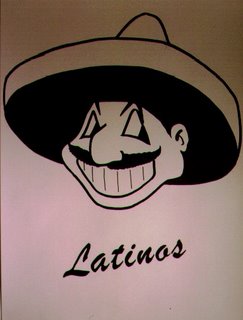WiDeR cOnTeXt: RePrEsEnTaTiOn Of LaTiNoS
In Prison Break, there are a number of different ethnic minorities represented from Black African Americans to Russians to hispanic latino males. Below is an overview of Latino representations in the media and society.
 Latinos are a minority that are faced with this character distortion repeatedly. They insist that most English-language media paint an overwhelmingly negative portrait of their lives plagued by hopeless poverty, crime, and violence. Latin adults report that the majority of the images "failed to reflect their experiences with sensitivity or realism." These images not only encourage young people in the Latino community to form negative images of themselves and their peers.
Latinos are a minority that are faced with this character distortion repeatedly. They insist that most English-language media paint an overwhelmingly negative portrait of their lives plagued by hopeless poverty, crime, and violence. Latin adults report that the majority of the images "failed to reflect their experiences with sensitivity or realism." These images not only encourage young people in the Latino community to form negative images of themselves and their peers.
Historically, most mainstream media vehicles such as television, radio, film, newspapers, and magazines have ignored the Latin community. Latin-oriented news events, stories, and programs were confined to Spanish-language media and smaller, community-oriented newspapers. In recent years, Latinos have gained more exposure on the news, however, they are discussed in reference to social issues including welfare, illegal immigration, or criminal activity. This kind of negative exposure . In addition, Latin youth are typically portrayed in news stories involving them as drug dealers or users, gang members, teen mothers, and high school dropouts.
Television consistently features Latinos in minor roles, often as maids, janitors, drug lords or gang members rather than featuring them in lead roles portraying upper or middle class citizens. "Latinos in television and film are often used as background to offset other main characters." At best, they come off as uneducated and underpaid citizens of ridicule and at worst, they are depicted as immoral, lazy, or even criminals.
Recently, small improvements have been made in integrating Latinos into mainstream network television. For example, NYPD Blue cast a Latino in a significant and positive role on the show, a police detective. Rather than having a Latino causing the problems, this program placed a Latino in a law enforcement position, trying to improve societal conditions. In addition, Sesame Street includes minorities as positive community role models who foster children’s appreciation of diverse cultures and languages.
"The media affects people most when they do not have frames of reference to help them interpret what they see." The mainstream news and television media should make a deliberate effort to include more positive stories and references of young Latinos as assets to society, rather than focusing on the negative stories and images that have dominated their coverage. This may help stop negative stereotypes from perpetuating, thus breaking the cycle that causes tension and animosity within society.
http://icsdev.soe.umich.edu/confur/stories/reader/fall/ody$9f4e66bbfe551476a07ab3ed2d99c9ce
 Latinos are a minority that are faced with this character distortion repeatedly. They insist that most English-language media paint an overwhelmingly negative portrait of their lives plagued by hopeless poverty, crime, and violence. Latin adults report that the majority of the images "failed to reflect their experiences with sensitivity or realism." These images not only encourage young people in the Latino community to form negative images of themselves and their peers.
Latinos are a minority that are faced with this character distortion repeatedly. They insist that most English-language media paint an overwhelmingly negative portrait of their lives plagued by hopeless poverty, crime, and violence. Latin adults report that the majority of the images "failed to reflect their experiences with sensitivity or realism." These images not only encourage young people in the Latino community to form negative images of themselves and their peers.Historically, most mainstream media vehicles such as television, radio, film, newspapers, and magazines have ignored the Latin community. Latin-oriented news events, stories, and programs were confined to Spanish-language media and smaller, community-oriented newspapers. In recent years, Latinos have gained more exposure on the news, however, they are discussed in reference to social issues including welfare, illegal immigration, or criminal activity. This kind of negative exposure . In addition, Latin youth are typically portrayed in news stories involving them as drug dealers or users, gang members, teen mothers, and high school dropouts.
Television consistently features Latinos in minor roles, often as maids, janitors, drug lords or gang members rather than featuring them in lead roles portraying upper or middle class citizens. "Latinos in television and film are often used as background to offset other main characters." At best, they come off as uneducated and underpaid citizens of ridicule and at worst, they are depicted as immoral, lazy, or even criminals.
Recently, small improvements have been made in integrating Latinos into mainstream network television. For example, NYPD Blue cast a Latino in a significant and positive role on the show, a police detective. Rather than having a Latino causing the problems, this program placed a Latino in a law enforcement position, trying to improve societal conditions. In addition, Sesame Street includes minorities as positive community role models who foster children’s appreciation of diverse cultures and languages.
"The media affects people most when they do not have frames of reference to help them interpret what they see." The mainstream news and television media should make a deliberate effort to include more positive stories and references of young Latinos as assets to society, rather than focusing on the negative stories and images that have dominated their coverage. This may help stop negative stereotypes from perpetuating, thus breaking the cycle that causes tension and animosity within society.
http://icsdev.soe.umich.edu/confur/stories/reader/fall/ody$9f4e66bbfe551476a07ab3ed2d99c9ce

0 Comments:
Post a Comment
<< Home